After some doubts at the beginning of the season, Julen Lopetegui’s Sevilla are in great form. They sat third in the table before the COVID-19 stopped La Liga, and they will look to maintain their form and qualify for next season’s UEFA Champions League.
Sevilla’s last three matches in La Liga saw them win against Getafe (3-0 away) and Osasuna (3-2 at home) and draw against Atlético Madrid (2-2 away). Their first match after the forced break will be a city derby against Real Betis, in which the European aspirations of both clubs will be in play. In this tactical analysis, we will look at the tactics behind Sevilla’s success and what we can expect from them until the end of the season.
Formations and lineups
Sevilla usually use a 4-3-3 formation. This formation allows them to change to a 3-4-3 or a 4-1-4-1 with minimal variations, being very adaptable and changeable even within the same match. We can usually see the defensive midfielder dropping between the centre-backs to form a back-three or the wingers stepping back into midfield to defend and form a 4+1 midfield. This adaptability allows Lopetegui to easily implement different tactics.
But regardless what the formation looks like on paper, Sevilla usually try to use similar tactics. Their principles don’t change from match to match, looking to exploit the wings, from where Navas and Reguilón or Escudero from the wing-back position and Ocampos and Suso from the winger position create most of the team’s opportunities.
They also try to use quick transitions to take advantage of the pace they have on the wings and upfront (especially when Youssef En-Nesyri is their striker). They use their central midfielders to launch their quick transitions with their passing range. Sevilla rarely look to recycle possession and attempt positional attacks.
Below we see the average position and passing networks of Sevilla. We see the full-backs playing as wide midfielders, the defensive midfielder close to the centre-backs and the strikers isolated and not participating in the build-up. In this scout report, we will provide an analysis of these trends.

Playing from the back
When playing from the back, Sevilla usually form a back-three with the defensive midfielder dropping between the centre-backs. The full-backs step forward and the wingers and central midfielders use rotations to generate spaces. When facing intense pressure, Sevilla don’t mind playing long balls to En-Nesyri or Luuk De Jong and try to win second balls.
In general, Sevilla don’t take excessive risks and the main goal they have when building from the back is attracting pressure so they can exploit their quick transitions and wing players. It’s because of their patience to build from the back and wait for the correct moment to progress that Sevilla have the fourth highest possession in the league (56.9%).
Let’s see this in a practical example. In the picture below, we can see Sevilla building up from the back in their match against Osasuna. The first thing we notice is the defensive midfielder Fernando dropping between the centre-backs and forming a back three, liberating the full-backs to get more advanced positions.
On the right side of the attack, we see the right-back, the right-winger and the right central midfielder (Navas, Ocampos and Vázquez) grouping together and overloading the zone to attract players and generate spaces on the other side. On the left side, in opposition, Sevilla look to separate their players to generate spaces to play; the left-central midfielder (Óliver Torres) stays central and the left-back (Escudero) moves to the touchline, so the right-winger (Rony Lopes) has space to come and receive the ball. With this support movement, Lopes attracts the opposition’s right-back, generating a space either him or Escudero can attack to advance. In this case, Escudero receives the ball and it’s Lopes who attacks the space he generated.
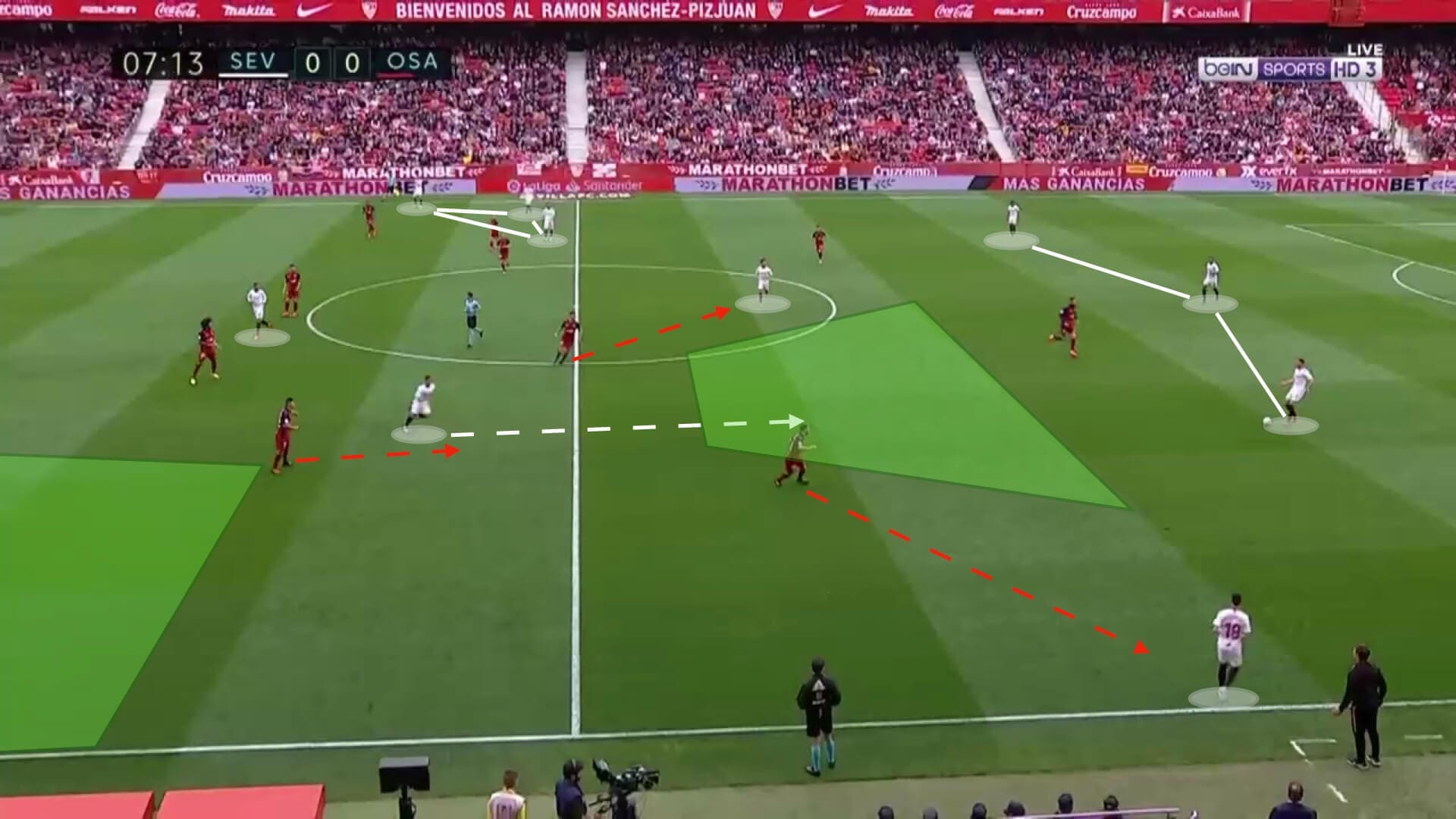
Another movement Sevilla frequently use to progress is the rotation between the central-midfielder and the winger. When one of the centre-backs has the ball, the winger comes inside and runs towards the ball to receive it, while the central midfielder attacks the half-space trying to take advantage of the space generated by the winger’s movement. This leaves the ball-possessor with two options: a short pass to the winger or a long pass in behind to the central midfielder. It also creates doubts in the opposition defence as players have to be coordinated to follow their marks or stay in their zones.
Let’s see an example of this in the next picture. When the right centre-back (Kundé) has the ball, the right central midfielder (Vázquez) and the right-winger (Ocampos) rotate their positions, with each one occupying the space generated and previously occupied by the other. In this case, Osasuna’s left-back doubts between following his mark or staying in his position and leaves the space for an easy pass to be played for Ocampos; should have him followed Ocampos, a long pass to Vázquez would have been a good option.
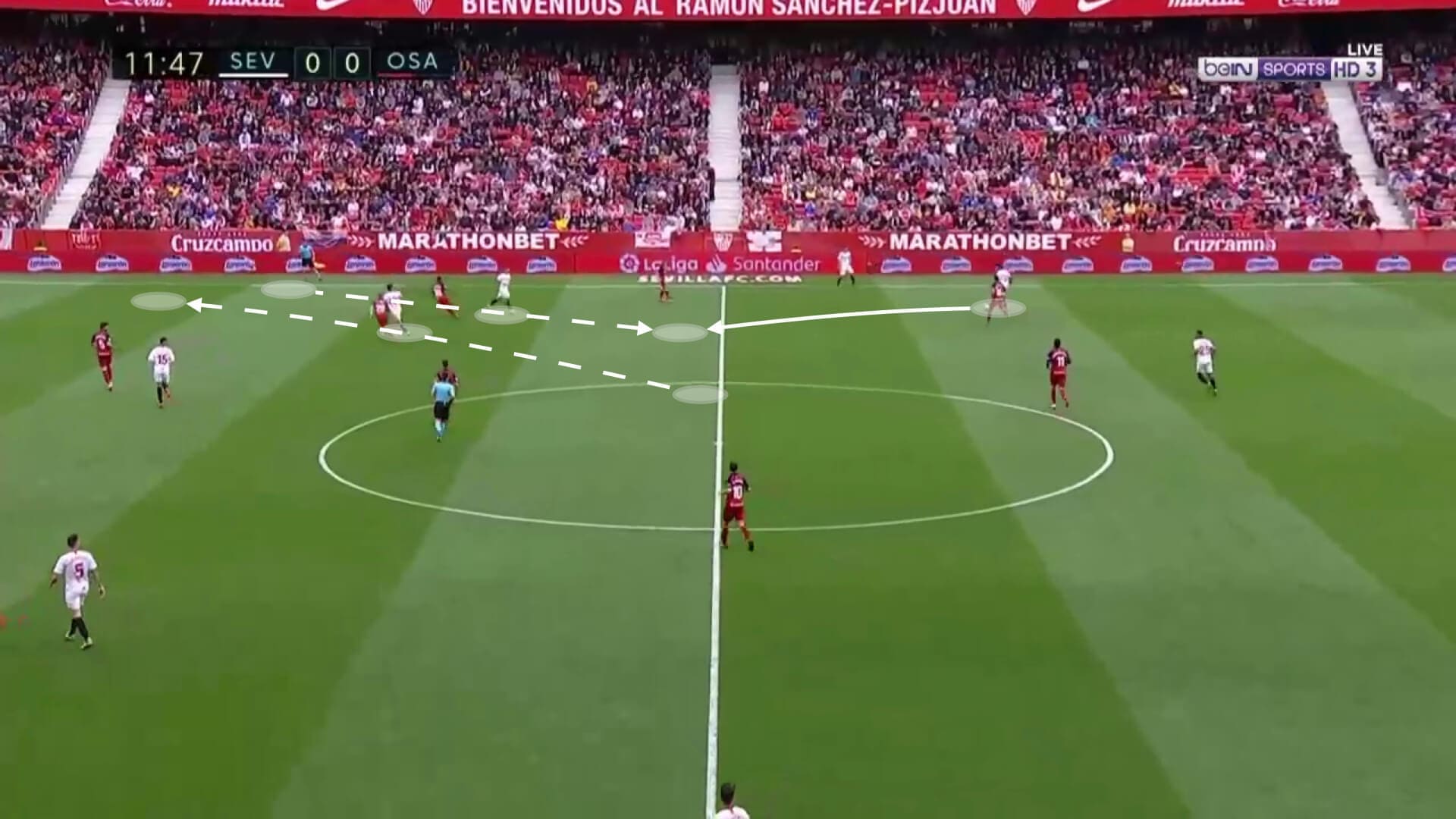
As we will see later on in this scout report, having three at the back from the beginning of the plays is a way Sevilla have to give more freedom to more advanced players and still feel safe in case there’s a counterattack.
Quick transitions and lack of positional play
As we said before, Sevilla’s high possession is mostly explained by their patience to build from the back, as they are not a team that looks to have long possessions in the opposition third. Sevilla’s main strength is their quick transitions. When they recover the ball or attract pressure, Sevilla look to quickly move the ball to free zones on the flanks and progress or counterattack from there using their full-backs and wingers pace and ability to carry the ball forward.
The first thing to note is that even if both full-backs are usually very attacking-minded, Navas is extremely direct and can often be seen in very advanced positions. The full-backs Navas and Reguilón are the top two crossers in La Liga (6.61 and 5.34 crosses per 90) and the seventh and fifth-best progressive runners respectively (3.44 and 3.63 progressive runs per 90). Considering Navas is also fifth in progressive passes (11.81 per 90), we can see how important full-backs are in Sevilla’s attacking tactics.
In the picture below, we see how Navas starts his overlapping run as soon as the pass to the winger is made, creating a superiority situation. Note how the full-back (Escudero, right-bottom corner) starts to run too but stays in a less advanced position. Navas’ tendency to rush forward as soon as he can is one of the reasons why right centre-back Kundé is such an important player in Lopetegi’s tactics. The young French is quick and good at defending with space, so he acts as the right-back when Navas can’t recover his position on time. The defensive midfielder staying near the centre-backs to form a back-three is also a way of liberating the full-backs without losing the defensive shape.
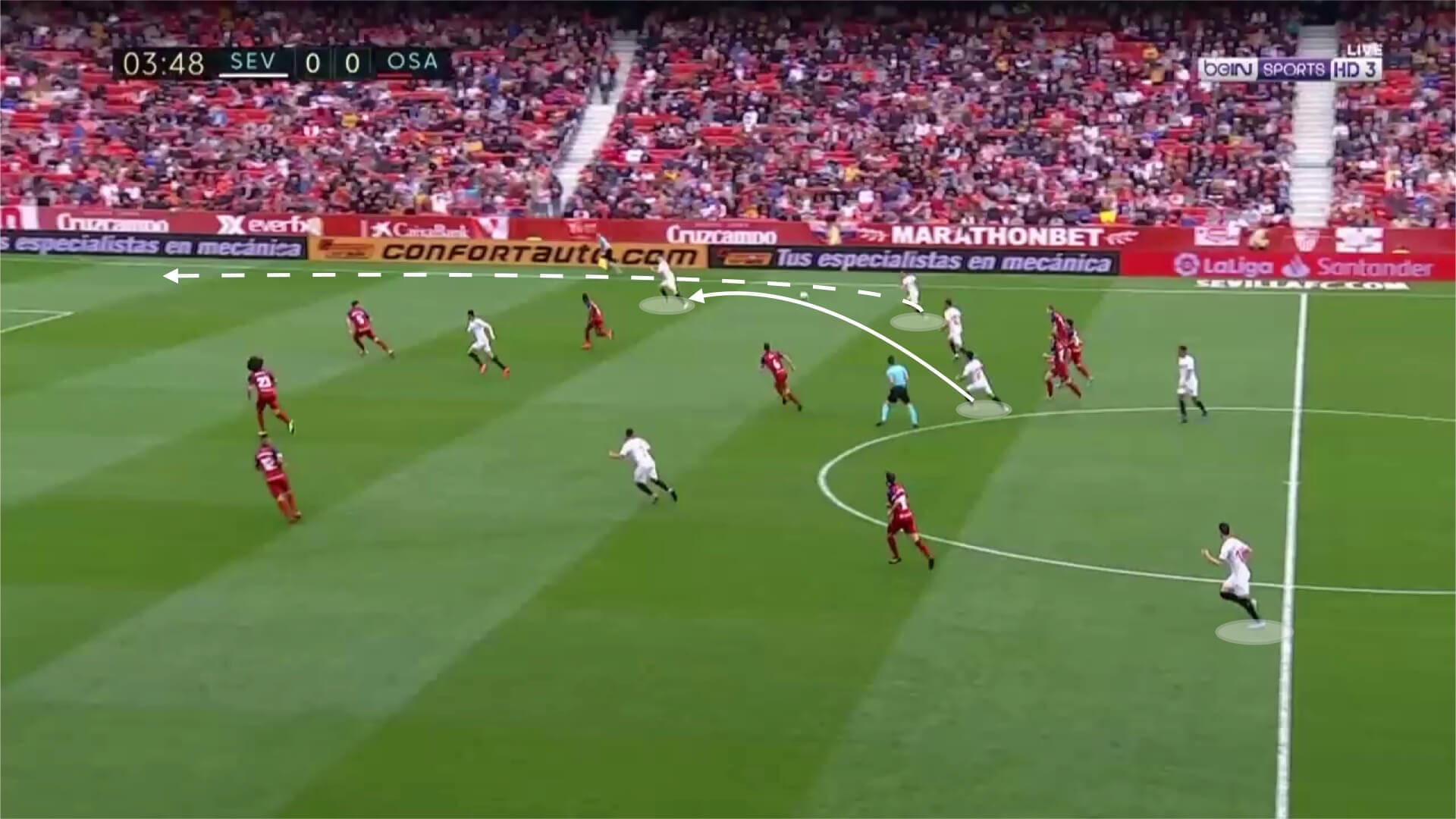
Again in the example below, the right-winger receives a pass and, as soon as he does, Navas is already overlapping him. Navas’ resurgence put him as the favourite to take the starting right-back spot in the National Team, even if he’s already 34 years old. In this picture, we can also see how Sevilla don’t usually use attacking midfielders and prefer progressing by the wings rather than through the middle.
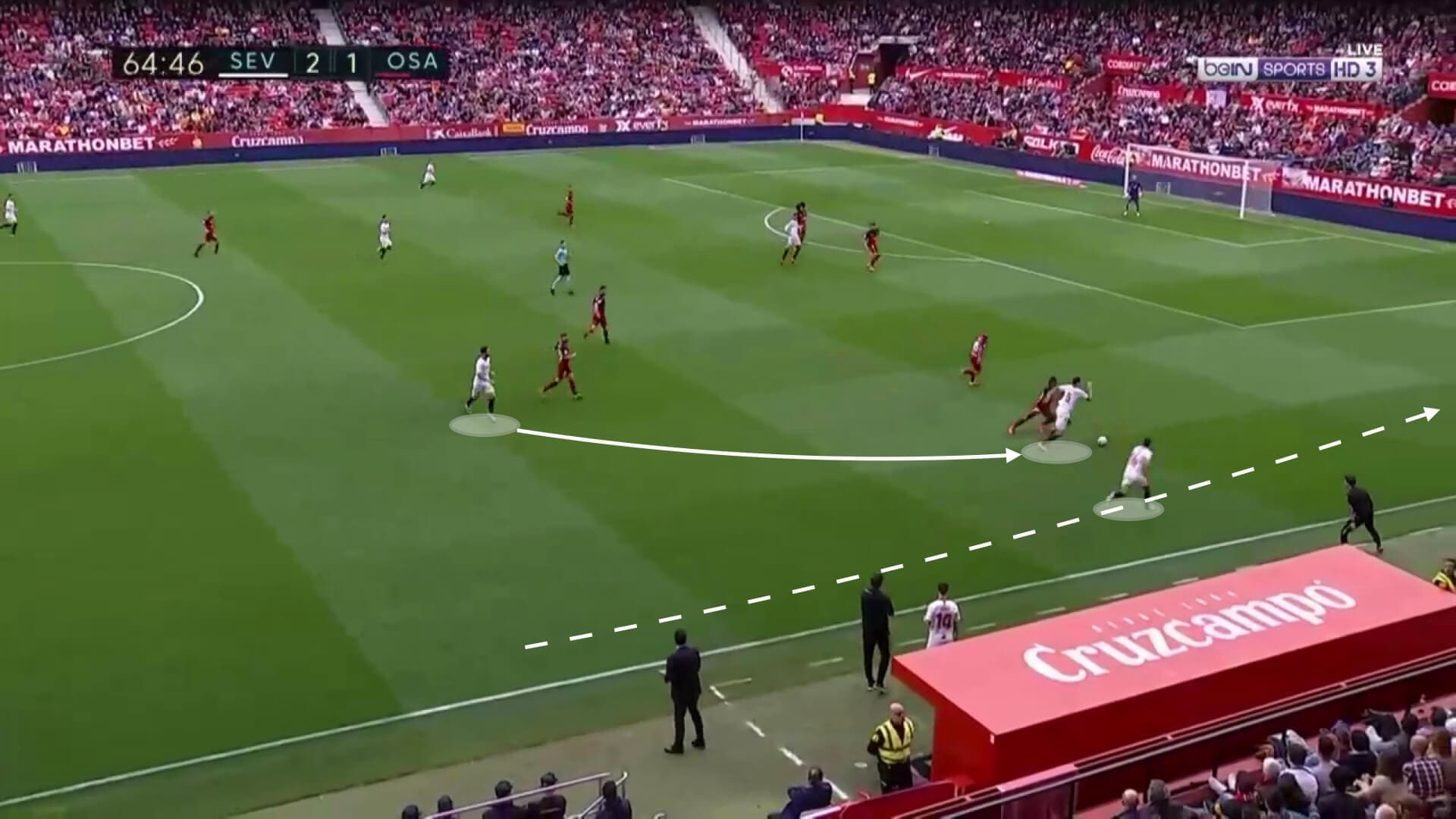
The lack of a proper number 10 in Sevilla’s tactics doesn’t mean their midfielders are not attacking minded. With the likes of Banega, Torres, Jordan and Vázquez, their midfield is full of talent, but they prefer to use them in deeper positions to progress the ball than between the lines to receive and assist. This is understandable seeing how well the wing players have performed.
Anyway, there’s one of Sevilla’s central midfielders that stand out above everyone else: Banega. The Argentinian playmaker, who’s leaving the club at the end of the season to sign for Al Shabab Riyadh, is sixth in La Liga for passes per 90 (68.13, 86% accuracy), second in passes to the final third per 90 (12.95) and third in progressive passes per 90 (12.99). His ability to dominate and dictate from midfield has been key in the last few years for Sevilla, and they will certainly miss him next season.
In the next example, we see how Sevilla use their central midfielders to launch their transitions. Torres, the man in possession, has just recovered the ball and is surrounded by rivals. Even if his teammate is under pressure, the left-back and the left-winger (Escudero and Lopes) start running forward, and Torres automatically know that and plays a pass into the run of Escudero. Lopes continues his run until he reaches the box, and Escudero finds free space to carry the ball to the edge of the box and shoot. Sevilla often launch counterattacks right after recovering the ball and the pace of their wide players is their main threat.
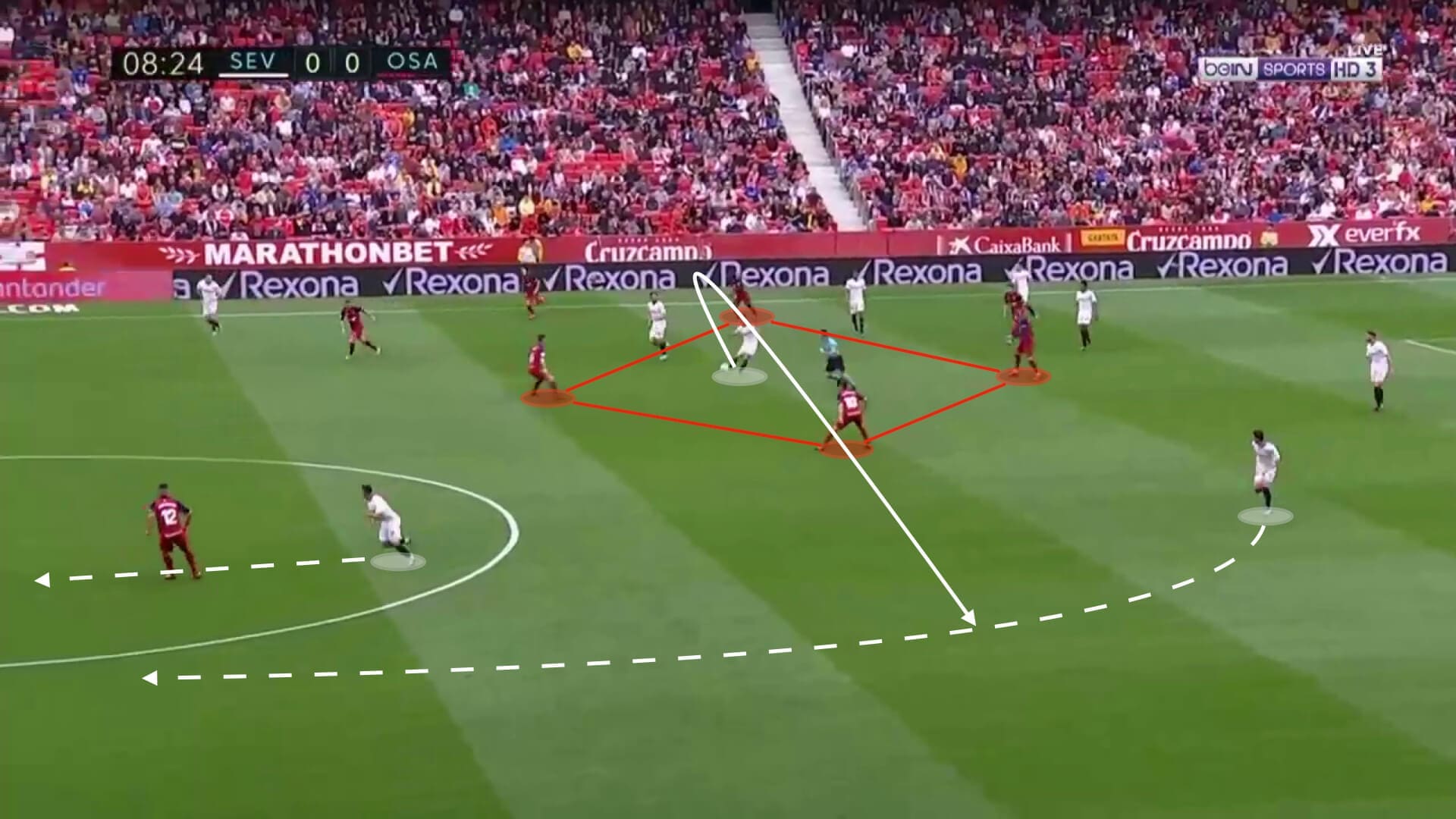
The player who has benefited the most from these quick transitions and playing with spaces is Ocampos. The Argentinian winger is the eighth top scorer in the league (10 goals), ninth in shots taken (55, 2.43 per 90), ninth in touches in the box per 90 (4.24), fifth in dribbles per 90 (8.75), tenth in progressive runs per 90 (3.27) and fourth in offensive duels per 90 (16.79). Thanks to his pace, physicality and aggressiveness to attack the spaces both with and without the ball, Ocampos is enjoying a revival season after some up and downs in the Ligue 1.
Sevilla’s tendency to attack using the wings is clearly seen in stats. Only 33% of their attacks come from the centre, with only Getafe having a lower percentage (32%). They lead the league in crosses (20.79 per 90) and are second in dribbles (29.42 per 90), generating 19.21 touches in the box per 90 (third-best) which lead to 11.55 shots per 90 (fourth-best). With this stats, it’s obvious Sevilla’s attacking tactics are being effective. In fact, they’re slightly underperforming their expected goals (38 goals from 41.62 xG), so only their bad finishing is preventing them from doing even better.
Defensive tactics: aggressive but not constant pressure
Sevilla’s defensive tactics are a mix of pressing and waiting. They don’t press all around the pitch but make sure the rivals are not comfortable and make them play through certain zones to then press very aggressively and recover the ball. This is done by someone joining the striker in the press, making the opposition centre-backs play to the desired side. Once that happens, the press very intensely and effectively. This leads to Sevilla being the second-best team in passes per defensive action (7.17), a metric that aims to measure how intensely and effectively teams press.
We see this kind of pressing in the next example. Osasuna don’t use a lot of players to build from the back, so Sevilla sense the weakness and press accordingly. The striker goes first, forcing the centre-back to pass to the right-back. Then, the right-winger and the right-back press their marks, while one of the central midfielders stays central to avoid any passes to the middle. This results in a recovery that ends in a shot. We can see Sevilla don’t put all the team forward to press, so it’s more a matter of organization than of numbers.
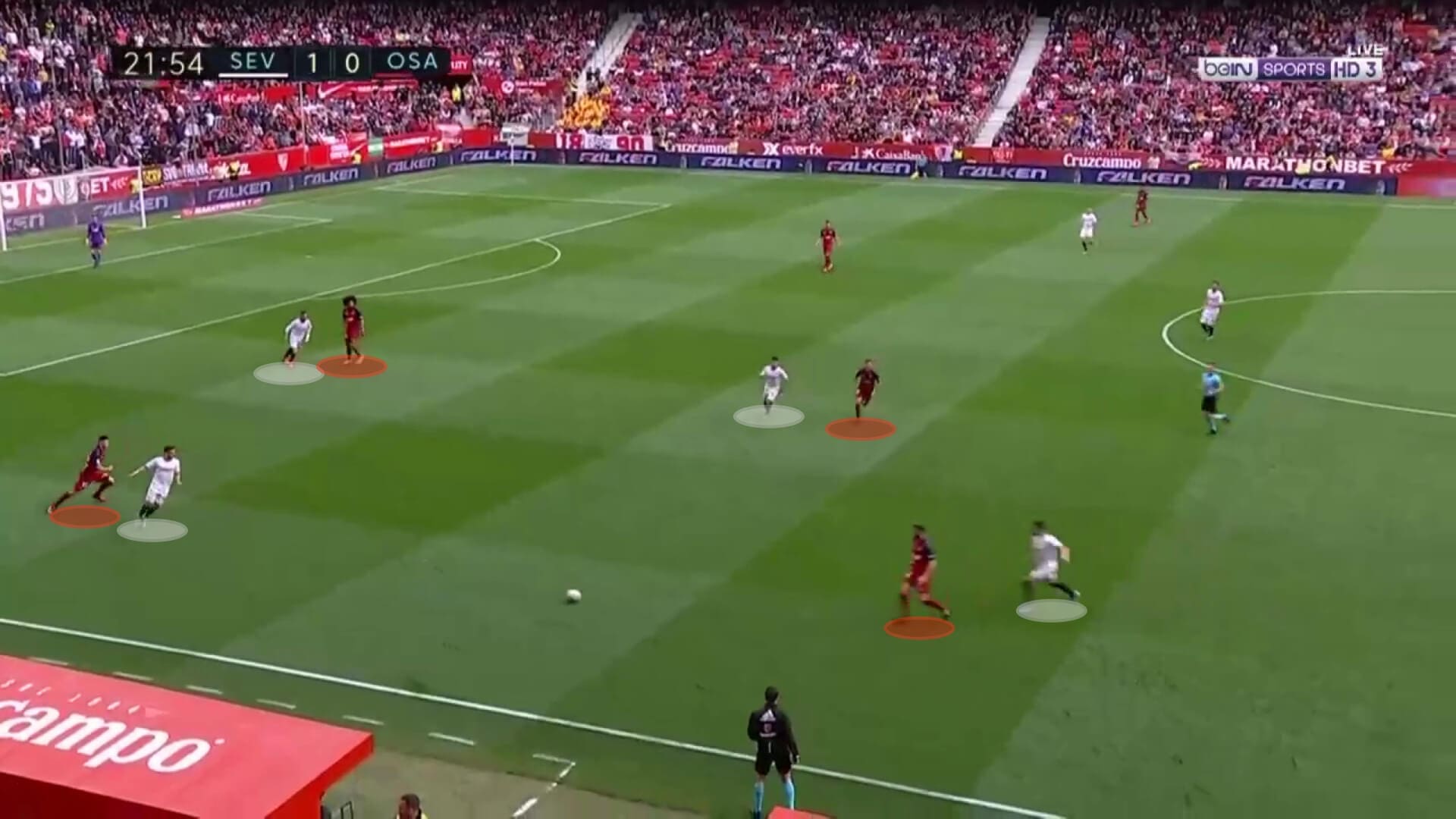
If the rivals play through Sevilla’s pressure, they always have at least four players ready to defend give time for the rest to recover their positions. The defensive midfielder is always near the centre-backs and at least one of the central midfielders stays close to his own half.
When there’s no opportunity to press, Sevilla defends in a middle-low block, forming a 5-4-1 formation with the defensive midfielder between the centre-backs. The striker prefers to stay in a slightly advanced position to make runs in behind as soon as the team recovers the ball. The pace of En-Nesyri is crucial in this last task. We can see this formation in the picture below.
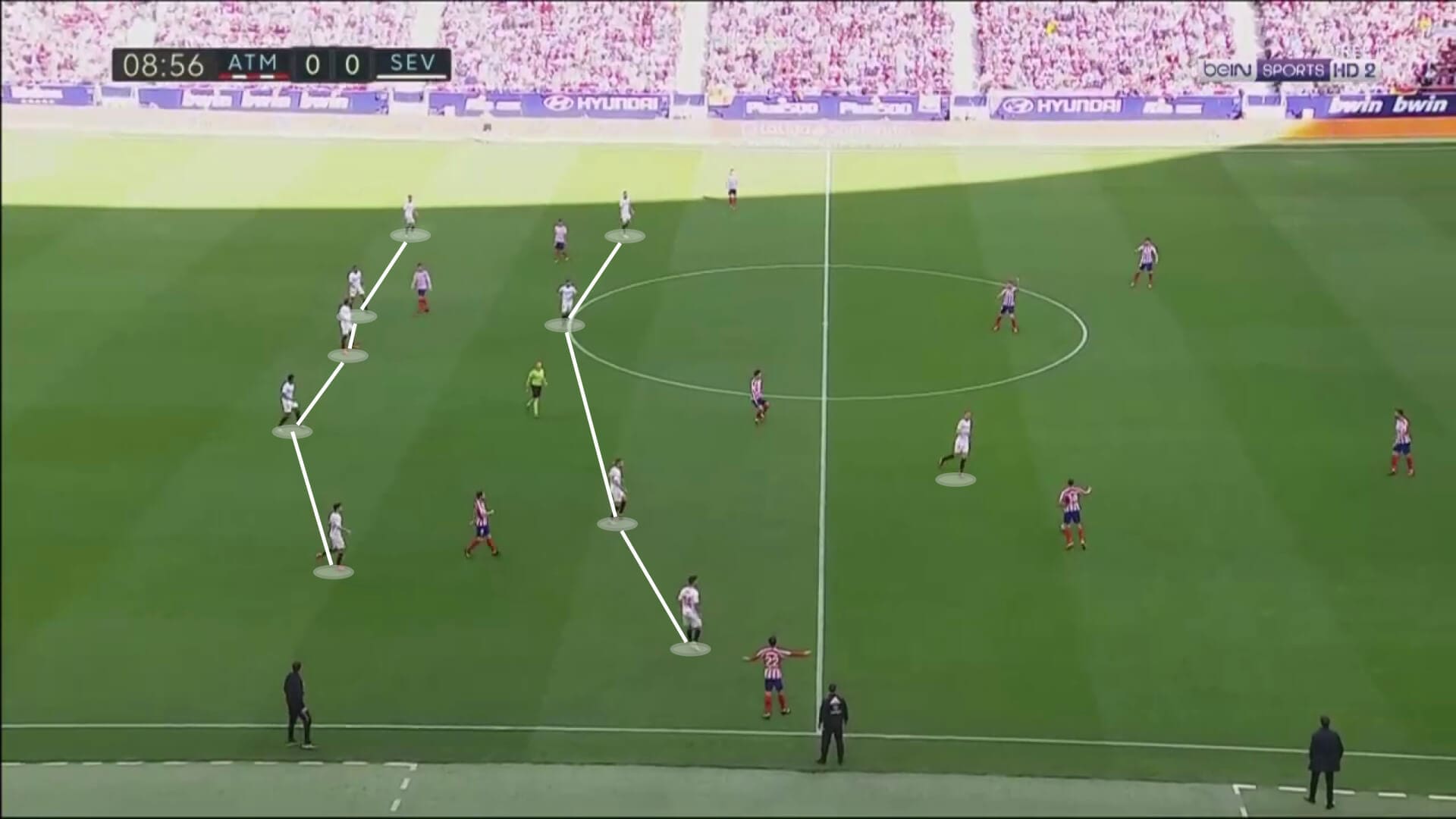
This defensive setup allows the defenders to leave their position to follow rival forwards to come deep to receive the ball. Take the play below as an example: João Felix comes deep to receive the ball in midfield and instead of leaving a midfielder to mark him, the right centre-back (Kundé) follows him and forces him to pass the ball back. Even if one of the centre-backs leaves his position, there’s still a solid back-four in place.
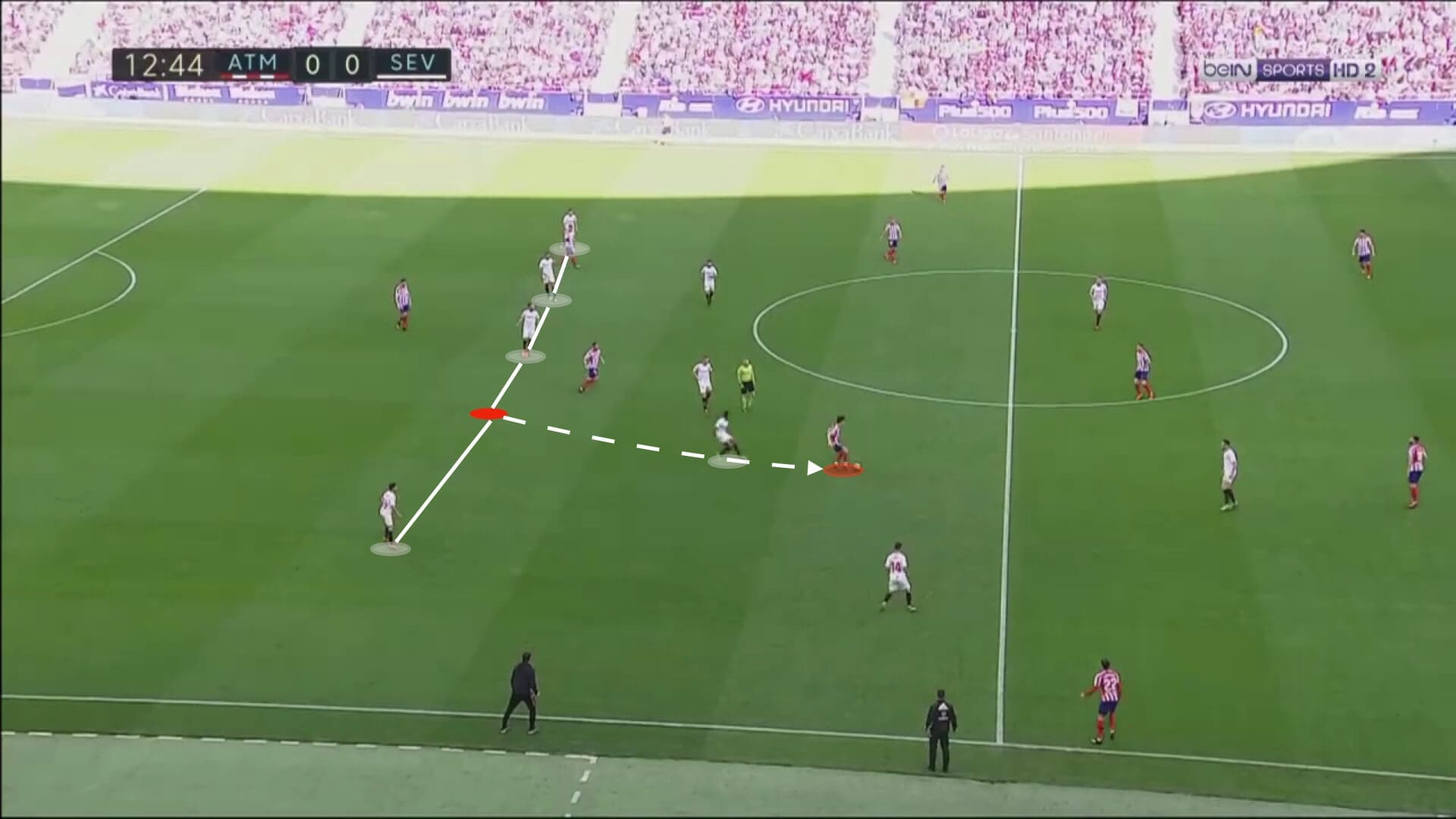
Sevilla’s defensive tactics have the advantage of being flexible enough to adapt the moment of the game in terms of pressing or waiting, and it’s been very effective as they are the fourth team who concedes the least shots (8.66 per 90, with a second-best 0.11 xGA/shot) and the fifth-best in goals against (29 from 28.10 xGA).
Conclusion
Sevilla have found a very sound playing style. Their defensive tactics have proven to be flexible and useful both to press high and sit low, while their quick transitions are a great way to take advantage of the spaces behind the opposition lines. They are underperforming their xG, so they can conclude they are on the correct path and a slight improvement in their finishing could be enough to make them a solid third-position candidate.
Tired of commentary which tells you nothing new about the action in front of you? Well, we’ve got a solution. We’ve partnered with HotMic to provide live commentary and analysis of the best football action from around the world, and we’re covering some of the best matches in the Bundesliga this weekend! Download the HotMic app and sign up using the code ‘TFA2020’ to keep up-to-date with all our coverage – we’ll be covering the Premier League, La Liga and Serie A as well when they resume, so make sure to follow us on the app, and get in-depth analysis and tactical knowledge from the best analysts in the business!
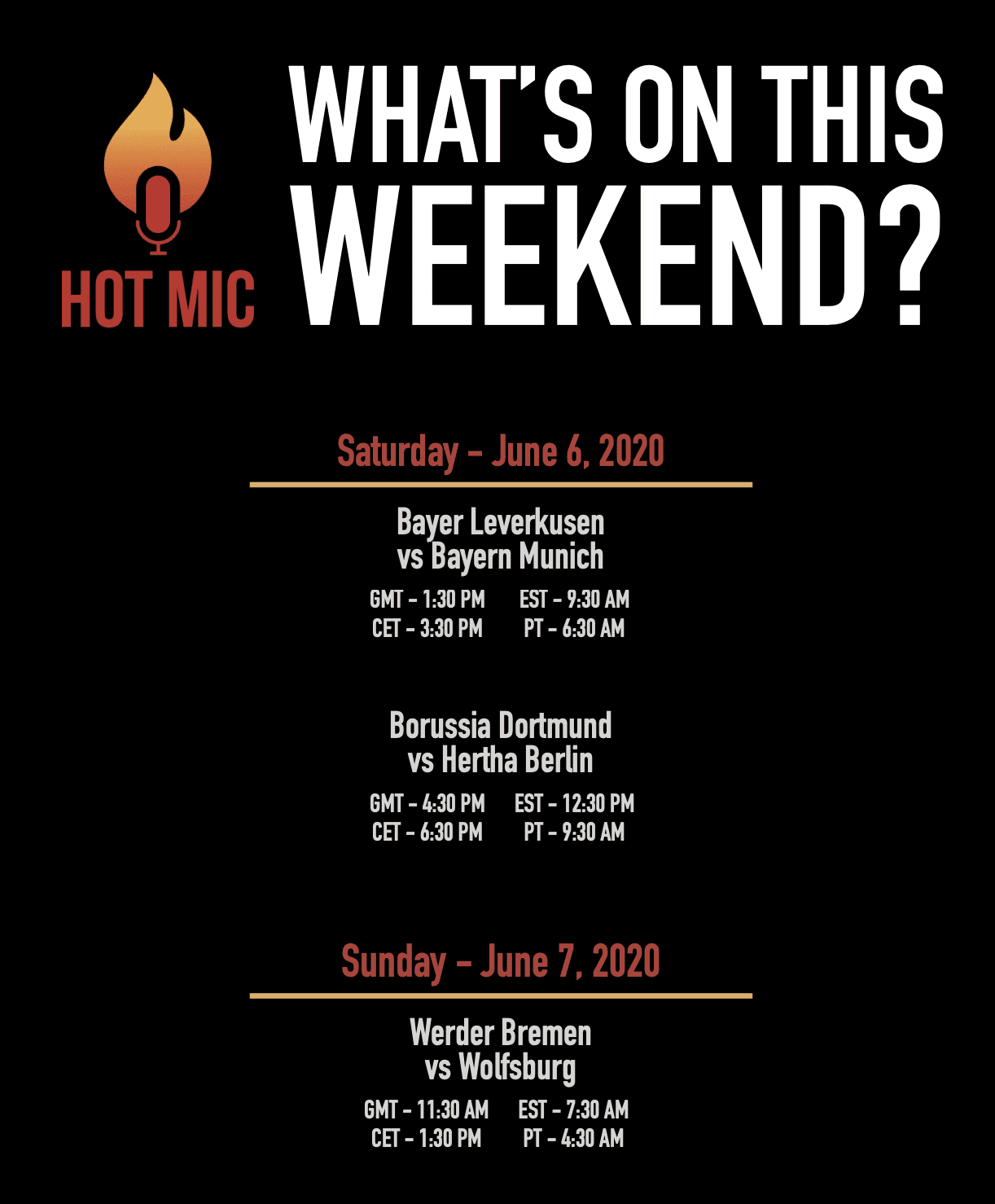





Comments